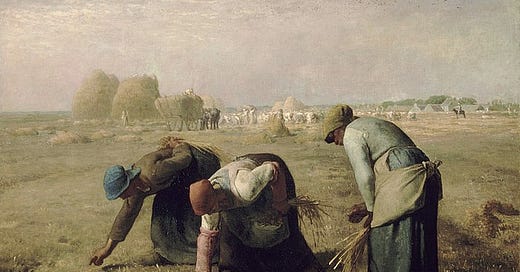In 1857, Jean-François Millet unveiled his work The Gleaners, depicting three women scavenging a wheat field for whatever was of use that the harvesters had left behind. It is bucolic, rustic, redolent of a bygone age, and it caused outrage when the upper echelons of society saw it.
Not that it was in any way inaccurate in its depiction: in fact, it was, for them, all too accurate. Hence the disdain that they showered upon it. How dare Millet confront them with their own, haughty greed?
Greed’s fruits we shall display with all our brazen ostentation,
But let no publick give utt’rance; for that, Goddamn, be not your station.
We plough our fields and scatter our good seed on our land,
And, be sure, ’tis fed and waterèd by our almighty hand —
For us, us alone, and not for commonality’s man.
To my mind, it is a magnificent painting. In its technique, in its accuracy, and precisely because it outraged the land-owning classes. Millet deserves a standing ovation to this day for having outraged them, and his painting should continue to outrage ruling classes who lord it, while their workers must scavenge for crumbs from their tables.
In the foreground, larger than life, on a canvas measuring nearly 4 feet by 3 feet, are the three women gleaners, whilst in the background is the hay wain piled high with the fruits of the Earth. But for the women’s clothing, it could be a scene from modern France, modern Asia or modern Africa. It could be a wheatfield, or it could be a rubbish tip, or it could be left-over goods from a supermarket. The harvest could be barrels of oil, sacks of coal or the revenue from income flowing into the pockets of the corrupt. The gleaners could be factory workers, manual labourers, or they could be agricultural pickers. The lowest of the low, beneath all contemplation or consideration. The scene has changed beyond recognition; its message has not. Not in over 150 years. Its detractors feared socialist revolution; and well they might.
Millet himself sold his canvas for but a derisory sum and was so ashamed of his “success” that he endeavoured to keep as a closely held secret the sale price of 3,000 francs (old francs, or 30 new francs; 163 euros at today’s values).
Twenty-four years after his death, Millet’s masterpiece sold for a hundred times what he’d received for it, and it now hangs in pride of place in Paris’s Orsay Museum.
Whether by accident or by design, the high-class critics of Millet’s work lowered its market value. And it would ultimately be the high-class purchaser after his death who paid its more realistic value. In a way, the critics of Millet’s criticism created a huge profit … for their own class, at the cost of the creator. It’s how the art market functions.
The Paris museum that displays the work today is under the aegis of the French Ministry of Culture. It does not criticise the painting, but vaunts it as one of the best of France’s artworks. It leaves the criticism up to the observer, just as ministries of culture should.
Must the deserving labourer always die before his contribution is justly valued?




